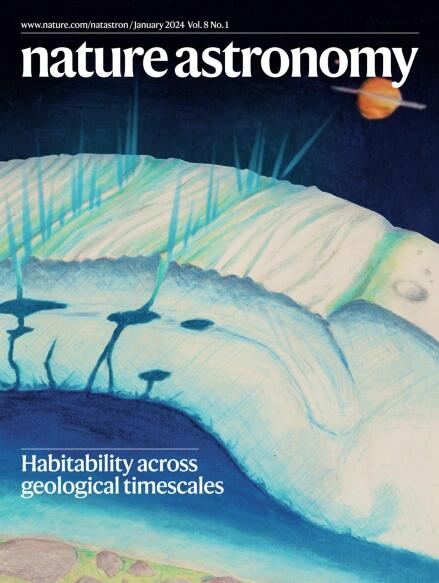A young gas giant and hidden substructures in a protoplanetary disk
IF 14.3
1区 物理与天体物理
Q1 ASTRONOMY & ASTROPHYSICS
引用次数: 0
Abstract
The detection of planets in protoplanetary disks has proven to be extremely challenging. By contrast, rings and gaps, usually attributed to planet–disk interactions, have been found in virtually every large protoplanetary (Class II) disk observed at 0.9–1.3 mm with sufficient spatial resolution (5 au). The nearby disk around MP Mus (PDS 66) stands as an exception to this rule, and its advanced age (7–10 Myr) is particularly difficult to reconcile with its apparent lack of substructures. Despite the disk’s smooth appearance, Gaia data of MP Mus show a significant proper motion anomaly, signalling the presence of a companion. Here we present ALMA 3-mm observations of the system with high spatial resolution comparable to previous 1.3-mm data. The new observations pierce deeper into the disk midplane and reveal an inner cavity (<3 au) and a ring at 10 au. The disk structure inferred from ALMA observations narrows down the properties of the companion to a gas giant orbiting at 1–3 au, and hydrodynamic simulations further confirm that such a planet can produce the observed cavity. These independent pieces of evidence constitute an indirect but compelling detection of an exoplanet within a protoplanetary disk using Gaia astrometry. The detection of dust substructures in MP Mus, thanks to the lower optical depths at longer wavelengths, suggests that rings and gaps are even more abundant than previously thought. ALMA and Gaia data combine to reveal a young gas giant in the protoplanetary disk around MP Mus. Previously unseen substructures, visible only at longer wavelengths, suggest that more planets may hide in disks than previously thought.


一个年轻的气体巨星和隐藏在原行星盘中的子结构
在原行星盘中探测行星已被证明是极具挑战性的。相比之下,通常归因于行星-盘相互作用的环和间隙,几乎在每一个观测到的0.9-1.3毫米的大原行星(II类)盘上都有发现,有足够的空间分辨率(5 au)。MP Mus (PDS 66)附近的圆盘是这一规则的例外,它的高龄(7-10迈珥)特别难以与它明显缺乏子结构相协调。尽管这个圆盘表面光滑,但盖亚关于MP Mus的数据显示了一个明显的运动异常,这表明它存在一个伴星。在这里,我们提供了与以前的1.3毫米数据相当的高空间分辨率的ALMA 3毫米观测系统。新的观测结果更深入地穿透了圆盘的中部,揭示了一个3 au的内腔和一个10 au的环。从ALMA观测推断出的圆盘结构缩小了一颗环绕1 - 3au的气体巨星伴星的特性,流体动力学模拟进一步证实了这样一颗行星可以产生观测到的空腔。这些独立的证据构成了使用盖亚天体测量法间接但令人信服地探测到原行星盘中有一颗系外行星。由于在较长的波长下较低的光学深度,对MP Mus尘埃亚结构的探测表明,环和间隙比以前想象的要丰富得多。
本文章由计算机程序翻译,如有差异,请以英文原文为准。
求助全文
约1分钟内获得全文
求助全文
来源期刊

Nature Astronomy
Physics and Astronomy-Astronomy and Astrophysics
CiteScore
19.50
自引率
2.80%
发文量
252
期刊介绍:
Nature Astronomy, the oldest science, has played a significant role in the history of Nature. Throughout the years, pioneering discoveries such as the first quasar, exoplanet, and understanding of spiral nebulae have been reported in the journal. With the introduction of Nature Astronomy, the field now receives expanded coverage, welcoming research in astronomy, astrophysics, and planetary science. The primary objective is to encourage closer collaboration among researchers in these related areas.
Similar to other journals under the Nature brand, Nature Astronomy boasts a devoted team of professional editors, ensuring fairness and rigorous peer-review processes. The journal maintains high standards in copy-editing and production, ensuring timely publication and editorial independence.
In addition to original research, Nature Astronomy publishes a wide range of content, including Comments, Reviews, News and Views, Features, and Correspondence. This diverse collection covers various disciplines within astronomy and includes contributions from a diverse range of voices.
 求助内容:
求助内容: 应助结果提醒方式:
应助结果提醒方式:


